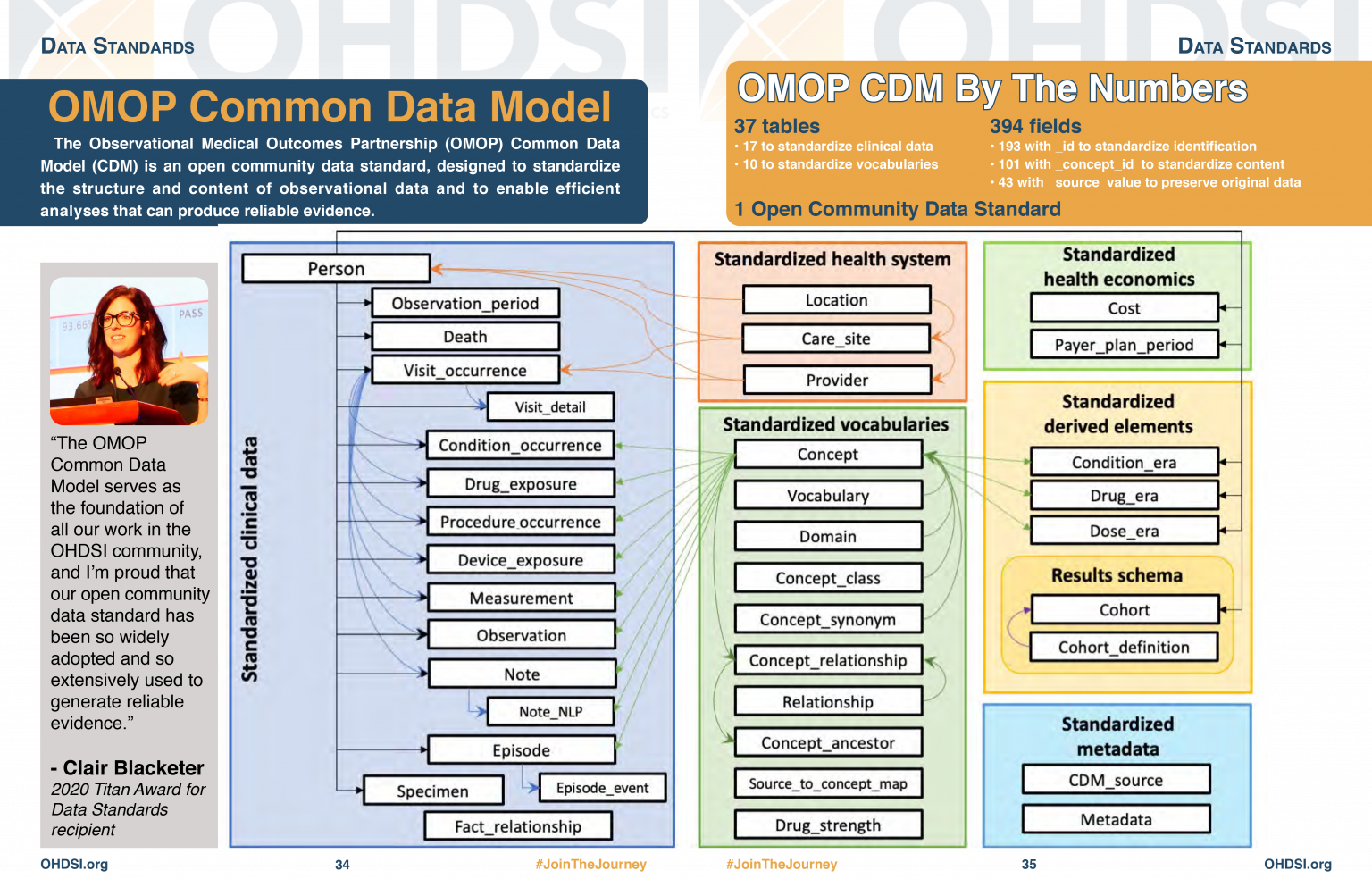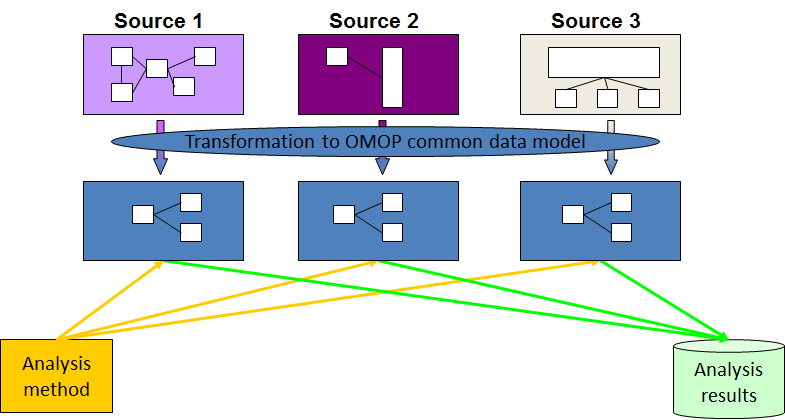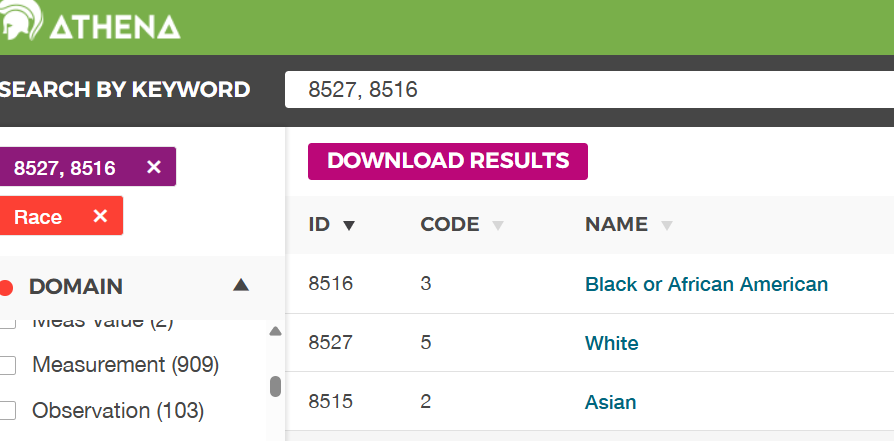Content from What is OMOP?
Last updated on 2025-12-03 | Edit this page
Estimated time: 0 minutes
Overview
Questions
- What is OMOP?
- Why is using a standard important in healthcare data?
- How do OMOP tables relate to each other?
- What are concept_ids and how can we get an humanly readable name for them?
Objectives
- Examine the diagram of the OMOP tables and the data specification
- Understand OMOP standardization and vocabularies
- Connect to an OMOP database and explore the
concepttable - Get a humanly readable name for a concept_id
Setting up R
Getting started
The “Projects” interface in RStudio not only creates a working directory for you, but also remembers its location (allowing you to quickly navigate to it). The interface also (optionally) preserves custom settings and open files to make it easier to resume work after a break.
Connect to a database
We will be using the CDMConnector package to connect to
an OMOP Common Data Model database. This package also contains synthetic
example data that can be used to demonstrate querying the data.
R
# Libraries
library(CDMConnector)
library(DBI)
library(duckdb)
library(dplyr)
library(dbplyr)
# Connect to GiBleed if not already connected
if (!exists("cdm") || !inherits(cdm, "cdm_reference")) {
db_name <- "GiBleed"
CDMConnector::requireEunomia(datasetName = db_name)
con <- DBI::dbConnect(duckdb::duckdb(),
dbdir = CDMConnector::eunomiaDir(datasetName = db_name))
cdm <- CDMConnector::cdmFromCon(con, cdmSchema = "main", writeSchema = "main")
}
OUTPUT
Download completed!Make sure everyone - has R open - has a project - has managed to connect to the database
Introduction
OMOP is a format for recording Electronic Healthcare Records. It allows you to follow a patient journey through a hospital by linking every aspect to a standard vocabulary thus enabling easy sharing of data between hospitals, trusts and even countries.
OMOP CDM Diagram

OMOP CDM stands for the Observational Medical Outcomes Partnership Common Data Model. You don’t really need to remember what OMOP stands for. Remembering that CDM stands for Common Data Model can help you remember that it is a data standard that can be applied to different data sources to create data in a Common (same) format. The table diagram will look confusing to start with but you can use data in the OMOP CDM without needing to understand (or populate) all 37 tables.
Challenge
Look at the OMOP-CDM figure and answer the following questions:
Which table is the key to all the other tables?
Which table allows you to distinguish between different stays in hospital?
The Person table
The Visit_occurrence table
Why use OMOP?

Once a database has been converted to the OMOP CDM, evidence can be generated using standardized analytics tools. This means that different tools can also be shared and reused. So using OMOP can help make your research FAIR.
Check that everyone knows what FAIR stands for
Read in the database as above.
The data themselves are not actually read into the created cdm object. Rather it is a reference that allows us to query the data from the database.
Typing names(cdm) will give a summary of the tables in
the database and we can look at these individually using the
$ operator and the colnames command.
OMOP Tables
R
names(cdm)
OUTPUT
[1] "person" "observation_period" "visit_occurrence"
[4] "visit_detail" "condition_occurrence" "drug_exposure"
[7] "procedure_occurrence" "device_exposure" "measurement"
[10] "observation" "death" "note"
[13] "note_nlp" "specimen" "fact_relationship"
[16] "location" "care_site" "provider"
[19] "payer_plan_period" "cost" "drug_era"
[22] "dose_era" "condition_era" "metadata"
[25] "cdm_source" "concept" "vocabulary"
[28] "domain" "concept_class" "concept_relationship"
[31] "relationship" "concept_synonym" "concept_ancestor"
[34] "source_to_concept_map" "drug_strength" Looking at the column names in each table
R
colnames(cdm$person)
OUTPUT
[1] "person_id" "gender_concept_id"
[3] "year_of_birth" "month_of_birth"
[5] "day_of_birth" "birth_datetime"
[7] "race_concept_id" "ethnicity_concept_id"
[9] "location_id" "provider_id"
[11] "care_site_id" "person_source_value"
[13] "gender_source_value" "gender_source_concept_id"
[15] "race_source_value" "race_source_concept_id"
[17] "ethnicity_source_value" "ethnicity_source_concept_id"Challenge
Question How do you think the visit_occurrence table is used to connect to the person table?
R
colnames(cdm$visit_occurrence)
OUTPUT
[1] "visit_occurrence_id" "person_id"
[3] "visit_concept_id" "visit_start_date"
[5] "visit_start_datetime" "visit_end_date"
[7] "visit_end_datetime" "visit_type_concept_id"
[9] "provider_id" "care_site_id"
[11] "visit_source_value" "visit_source_concept_id"
[13] "admitting_source_concept_id" "admitting_source_value"
[15] "discharge_to_concept_id" "discharge_to_source_value"
[17] "preceding_visit_occurrence_id"Looking at both tables we can see that they both have a column
labelled person_id which could be used to link them
together.
Notice that the visit_concept_id column in the visit_occurrence table is also a concept_id. This concept_id can be used to find out more information about the type of visit (e.g. inpatient, outpatient etc) by looking it up in the concept table. In this case the visit_concept_id is 9201 which relates to an inpatient visit. We can find this out by filtering the concept table for concept_id 9201 and selecting the concept_name column.
R
cdm$concept |>
filter(concept_id == 9201) |>
select(concept_name)
OUTPUT
# Source: SQL [?? x 1]
# Database: DuckDB 1.4.1 [unknown@Linux 6.8.0-1041-azure:R 4.5.2//tmp/Rtmpir2lFS/file16e64382d7af.duckdb]
concept_name
<chr>
1 Inpatient VisitA useful function
Finding the humanly readable name for a concept_id will be a useful
function. We can create a function get_concept_name() that
takes a concept_id as input and returns the concept_name.
Challenge
Create the function get_concept_name() that takes a
concept_id as input and returns the concept_name.
R
get_concept_name <- function(id) {
cdm$concept |>
filter(concept_id == !!id) |>
select(concept_name) |>
pull()
}
Explanation of function code
- The function is called
get_concept_nameand it takes one argument,id. - Inside the function, we query the
concepttable from thecdmobject. - We use the
filterfunction to select rows where theconcept_idmatches the inputid. The!!operator is used to unquote the variable so that its value is used in the filter. - We then use
selectto choose only theconcept_namecolumn from the filtered results. - Finally, we use
pull()to extract theconcept_nameas a vector, which is returned by the function.
Other useful tables
There are also other tables which will give you other information about concepts.
R
colnames(cdm$concept)
OUTPUT
[1] "concept_id" "concept_name" "domain_id" "vocabulary_id"
[5] "concept_class_id" "standard_concept" "concept_code" "valid_start_date"
[9] "valid_end_date" "invalid_reason" R
colnames(cdm$domain)
OUTPUT
[1] "domain_id" "domain_name" "domain_concept_id"R
colnames(cdm$vocabulary)
OUTPUT
[1] "vocabulary_id" "vocabulary_name" "vocabulary_reference"
[4] "vocabulary_version" "vocabulary_concept_id"- Using a standard makes it much easier to share data
- OMOP uses concepts to link different tables together
- The
concepttable contains humanly readable names for concept_ids
Content from Exploring OMOP concepts with R
Last updated on 2025-12-03 | Edit this page
Estimated time: 0 minutes
Overview
Questions
- Find the
vocabularyanddomainfor a given concept_id - Establish whether a concept_id is a standard concept
- Find all concepts within a given domain
- Find all concepts within a given vocabulary
Objectives
- Understand that concepts have additional attributes such as vocabulary, domain, and standard concept status
- Use R to query the
concepttable for specific attributes of concepts - Filter concepts based on domain and vocabulary
- Identify standard concepts within the OMOP vocabulary
Introduction
Nearly everything in a hospital can be represented by an OMOP concept_id.
Any column within the OMOP CDM named *concept_id
contains OMOP concept IDs. An OMOP concept_id is a unique integer
identifier. Concept_ids are defined in the OMOP concept table where a
corresponding name and other attributes are stored. OMOP contains
concept_ids for other medical vocabularies such as SNOMED and LOINC,
which OMOP terms as source vocabularies.
Looking up OMOP concepts
OMOP concepts can be looked up in Athena an online tool provided by OHDSI.
The CDMConnector package allows connection to an OMOP Common Data Model in a database. It also contains synthetic example data that can be used to demonstrate querying the data.
In the previous lesson we set up the CDMConnector package to connect
to an OMOP Common Data Model database and used it to look at the
concepts table. We also created the function
get_concept_name() to get a humanly readable name for a
concept_id. ### Setting up the connection
R
library(CDMConnector)
db_name <- "GiBleed"
CDMConnector::requireEunomia(datasetName = db_name)
OUTPUT
Download completed!R
db <- DBI::dbConnect(duckdb::duckdb(),
dbdir = CDMConnector::eunomiaDir(datasetName = db_name))
cdm <- CDMConnector::cdmFromCon(con = db, cdmSchema = "main",
writeSchema = "main")
Exploring the concept table
R
colnames(cdm$concept)
OUTPUT
[1] "concept_id" "concept_name" "domain_id" "vocabulary_id"
[5] "concept_class_id" "standard_concept" "concept_code" "valid_start_date"
[9] "valid_end_date" "invalid_reason" | concept table columns | Description |
|---|---|
| concept_id | Unique identifier for the concept. |
| concept_name | Name or description of the concept. |
| domain_id | The domain to which the concept belongs (e.g. Condition, Drug). |
| vocabulary_id | The vocabulary from which the concept originates (e.g. SNOMED, RxNorm). |
| concept_class_id | Classification within the vocabulary (e.g. Clinical Finding, Ingredient). |
| standard_concept | ‘S’ for standard concepts that can be included in network studies |
| concept_code | Code used by the source vocabulary to identify the concept. |
| valid_start_date | Date the concept became valid in OMOP. |
| valid_end_date | Date the concept ceased to be valid. |
| invalid_reason | Reason for invalidation, if applicable |
The concept table is the main table for looking up information about concepts. We can use R to query the concept table for specific attributes of concepts.
Challenge
Answer the following questions using R and the concept table:
How many entries are there in the concept table?
How many distinct vocabularies are there in the concept table?
How many distinct domains other than ‘None’ are there in the concept table?
R
# 1. How many entries are there in the concept table?
cdm$concept %>% summarise(n_concepts = n())
ERROR
Error in summarise(., n_concepts = n()): could not find function "summarise"Answer: There are 444 entries in the concept table. This is a tiny fraction of the overall table which can be found at Athena
R
# 2. How many distinct vocabularies are there in the concept table?
cdm$concept %>% summarise(n_distinct_vocabularies = n_distinct(vocabulary_id))
ERROR
Error in summarise(., n_distinct_vocabularies = n_distinct(vocabulary_id)): could not find function "summarise"Answer: There are 9 distinct vocabularies used in this dataset.
R
# 3. How many distinct domains other than 'None' are there in the concept table?
cdm$concept %>%
filter(domain_id != "None") %>%
summarise(n_distinct_domains = n_distinct(domain_id))
ERROR
Error in summarise(., n_distinct_domains = n_distinct(domain_id)): could not find function "summarise"Answer: There are 8 distinct domains other than ‘None’ in this dataset.
Filtering concepts by domain, vocabulary and standard concept status
Let’s look into filtering concepts based on their domain and vocabulary.
Challenge
Lists the first ten rows of the concept table, listing concept_id, domain_id, vocabulary_id and standard_concept columns.
R
cdm$concept |>
arrange(concept_id) |>
filter(row_number() <= 10) |>
select(concept_id, domain_id, vocabulary_id, standard_concept) |>
collect()
ERROR
Error in collect(select(filter(arrange(cdm$concept, concept_id), row_number() <= : could not find function "collect"Note we have to use collect() to pull the data into R
memory to view it.
Look at vocabularies
Vocabulary: The source or system of coding for concepts, such as SNOMED, RxNorm, LOINC, or ICD‑10. OMOP maps many vocabularies into a common, standardised set so different coding systems can be analysed together.
Challenge
List all distinct vocabularies in the concept table.
R
cdm$concept |>
filter(!is.na(vocabulary_id)) |>
distinct(vocabulary_id) |>
arrange(vocabulary_id) |>
pull(vocabulary_id)
ERROR
Error in pull(arrange(distinct(filter(cdm$concept, !is.na(vocabulary_id)), : could not find function "pull"Here we can use pull(x) to pull the data x into R memory
to view it.
Look at domains
Domain: A high‑level category that groups concepts by what they represent in clinical data, such as Condition, Drug, Procedure, Measurement, or Observation. A concept’s domain determines which OMOP table it belongs to and how it’s used analytically.
Challenge
List all distinct domains in the concept table.
R
cdm$concept |>
filter(!is.na(domain_id)) |>
distinct(domain_id) |>
arrange(domain_id) |>
pull(domain_id)
ERROR
Error in pull(arrange(distinct(filter(cdm$concept, !is.na(domain_id)), : could not find function "pull"Look at non standard concepts
A standard concept is the preferred, harmonised code in OMOP that represents a clinical idea across vocabularies. Standard concepts (standard_concept = “S”) are the target of mappings from source codes, and they define which domain and table the data belong to for consistent analysis.
Challenge
Find any nonstandard concepts (i.e. concepts where standard_concept is not ‘S’) by filtering the concept table. List the first 10 concept_ids of nonstandard concepts. Then look up their concept_name, domain_id, vocabulary_id and standard_concept status.
R
cdm$concept |>
filter(is.na(standard_concept) | standard_concept != "S") |>
slice_min(order_by = concept_id, n = 10, with_ties = FALSE) |>
pull(concept_id)
ERROR
Error in pull(slice_min(filter(cdm$concept, is.na(standard_concept) | : could not find function "pull"R
cdm$concept |>
filter(concept_id %in% c(1569708, 35208414, 44923712, 45011828)) |>
select(concept_id, concept_name, domain_id, vocabulary_id, standard_concept) |>
collect()
ERROR
Error in collect(select(filter(cdm$concept, concept_id %in% c(1569708, : could not find function "collect"Now you should be able to replicate our get_concept_name() function to look up other attributes of concepts such as domain, vocabulary and standard concept status.
Challenge
Questions?
Find the domain and vocabulary for concept_id 35208414
Is this concept a standard concept?
R
library(dplyr)
get_concept_domain <- function(id) {
cdm$concept |>
filter(concept_id == !!id) |>
select(domain_id) |>
pull()
}
get_concept_vocabulary <- function(id) {
cdm$concept |>
filter(concept_id == !!id) |>
select(vocabulary_id) |>
pull()
}
get_concept_standard_status <- function(id) {
cdm$concept |>
filter(concept_id == !!id) |>
select(standard_concept) |>
pull()
}
get_concept_domain(35208414)
OUTPUT
[1] "Condition"R
get_concept_vocabulary(35208414)
OUTPUT
[1] "ICD10CM"R
get_concept_standard_status(35208414)
OUTPUT
[1] NAAnswer:
The domain for concept_id 319835 is ‘Condition’.
The vocabulary for concept_id 319835 is ‘ICD10CM’.
This concept is not a standard concept (standard_concept = ‘NA’).
- Concepts have additional attributes such as vocabulary, domain, and standard concept status
- The
concepttable can be queried using R to retrieve specific attributes of concepts - Concepts can be filtered based on their domain and vocabulary
- Standard concepts are those that are recommended for use in analyses within the OMOP framework
Content from More on concepts
Last updated on 2025-12-03 | Edit this page
Estimated time: 0 minutes
Overview
Questions
Where to find other concept_ids in OMOP
How to link OMOP tables
Objectives
Understand that there are many other concept_ids in OMOP tables and that these are usually named with a _concept_id suffix.
Learn how to link OMOP tables using common identifiers such as person_id and visit_occurrence_id.
Be able to use the concept table to look up humanly readable names for various concept_ids.
Use joins to combine data from multiple OMOP tables based on common identifiers.
Introduction
In this episode, we will explore more concepts related to the OMOP Common Data Model (CDM). We will focus on understanding how different tables in the OMOP CDM are linked together through common identifiers. This knowledge is crucial for effectively querying and analysing healthcare data stored in the OMOP format.
Set up the database connection and import the get_concept_name function
R
library(CDMConnector)
db_name <- "GiBleed"
CDMConnector::requireEunomia(datasetName = db_name)
OUTPUT
Download completed!R
db <- DBI::dbConnect(duckdb::duckdb(),
dbdir = CDMConnector::eunomiaDir(datasetName = db_name))
cdm <- CDMConnector::cdmFromCon(con = db, cdmSchema = "main",
writeSchema = "main")
R
library(dplyr)
get_concept_name <- function(id) {
cdm$concept |>
filter(concept_id == !!id) |>
select(concept_name) |>
pull()
}
Other concept_ids in OMOP
In addition to the concept_id column in various OMOP
tables, there are several other columns that use *_concept_ids provide
information.
Look at the column names of the person table.
R
colnames(cdm$person)
OUTPUT
[1] "person_id" "gender_concept_id"
[3] "year_of_birth" "month_of_birth"
[5] "day_of_birth" "birth_datetime"
[7] "race_concept_id" "ethnicity_concept_id"
[9] "location_id" "provider_id"
[11] "care_site_id" "person_source_value"
[13] "gender_source_value" "gender_source_concept_id"
[15] "race_source_value" "race_source_concept_id"
[17] "ethnicity_source_value" "ethnicity_source_concept_id"Several of these columns end with _concept_id, such as
gender_concept_id, race_concept_id, and
ethnicity_concept_id. These columns link to the
concept table to provide humanly readable names for the
concepts represented by these IDs.
For example, to get the gender name for a person, you can use the
gender_concept_id column in the person table
and look it up in the concept table.
Unfortunately, the database we are using does not have any concept
data relating to the race_concept_id so we have provided a
snapshot of the relevant Athena data below.

Use the lists of concept ideas and the code below to create some mini tables.
R
library(dplyr)
patients <- c(1, 2, 3, 5, 6, 7, 9, 11, 12, 16)
visits <- c(79, 107, 262, 493, 561, 630, 771, 943, 1017, 1196)
mini_person <-
cdm$person |>
filter(person_id %in% patients) |>
select(
person_id,
year_of_birth,
gender_concept_id,
race_concept_id
) |>
arrange(person_id) |>
collect()
mini_condition_occurrence <-
cdm$condition_occurrence |>
filter(visit_occurrence_id %in% visits) |>
select(
condition_occurrence_id,
person_id,
condition_concept_id,
condition_start_date,
visit_occurrence_id
) |>
arrange(person_id) |>
collect()
mini_drug_exposure <-
cdm$drug_exposure |>
filter(visit_occurrence_id %in% visits) |>
select(
drug_exposure_id,
person_id,
drug_concept_id,
visit_occurrence_id
) |>
arrange(person_id) |>
collect()
Using the tables above, try to find the humanly readable names for
the various concept_ids using the get_concept_name()
function we created earlier.
Challenge
Using the mini_person,
mini_condition_occurrence, and
mini_drug_exposure tables created above, find the humanly
readable names for the various concept_ids using the
get_concept_name() function and answer the following
questions:
What is the gender of the Asian patient in the
mini_persontable?How many men and women are in the table?
What condition is associated with the drug “Aspirin 81 MG Oral Tablet” ?
- From the diagram above, we can see that the race_concept_id for an
Asian person is 8515. There is only one person in the
mini_persontable with this race concept. They have a gender_concept_id of 8507. Using theget_concept_name()function,
R
get_concept_name(8507)
OUTPUT
[1] "MALE"The asian patient is male.
- The table is small enough to actually count by hand but also we can use dplyr to count the number of men and women.
R
# Because we are getting our data from a database, let's create a mini version # of the concepts we want
gender_concept <- cdm$concept |>
filter(concept_id %in% c(8507, 8532)) |>
select(concept_id, concept_name) |>
collect()
# Now we can join to get the names
mini_person |>
left_join(gender_concept, by = c("gender_concept_id" = "concept_id")) |>
group_by(concept_name) |>
summarise(count = n())
OUTPUT
# A tibble: 2 × 2
concept_name count
<chr> <int>
1 FEMALE 6
2 MALE 4- First, we need to find the concept_id for “Aspirin 81 MG Oral Tablet”.
R
aspirin_concept_id <- cdm$concept |>
filter(concept_name == "Aspirin 81 MG Oral Tablet") |>
select(concept_id) |>
pull()
Next, we can use this concept_id to find the associated condition in
the mini_drug_exposure table and then look up the condition
name.
R
condition_concept_id <- mini_drug_exposure |>
filter(drug_concept_id == aspirin_concept_id) |>
select(person_id) |>
left_join(mini_condition_occurrence, by = "person_id") |>
select(condition_concept_id) |>
pull()
get_concept_name(condition_concept_id)
OUTPUT
[1] "Otitis media"OMOP tables contain many concept_ids, usually named with a _concept_id suffix.
The concept table can be used to look up humanly readable names for various concept_ids.
OMOP tables can be linked using common identifier.
